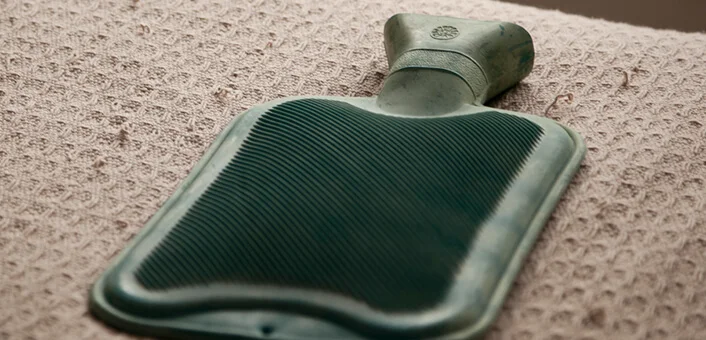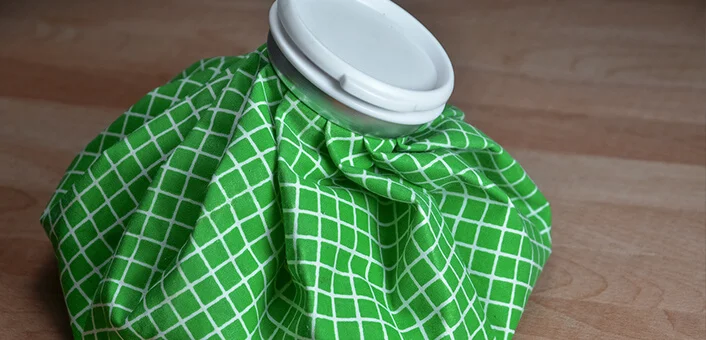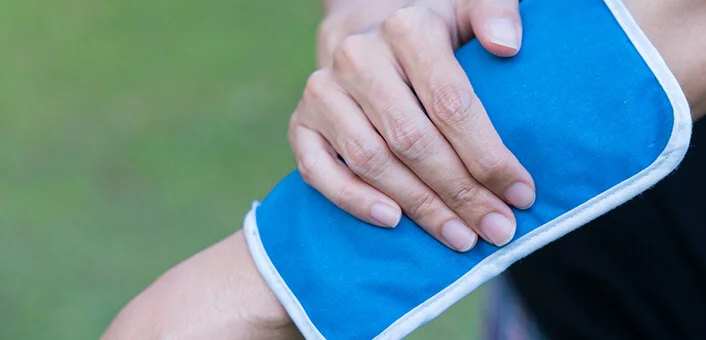“Doctor, my arthritis pain has come back. I am using the knee sock and it seems to help. But would you recommend I apply cold packs to ease my pain. Or wait… do you think I should use hot packs?”
As a medical practitioner, I have faced this question many times. Friends and relatives of patients recommend the use of hot and cold packs based on their own experience or hearsay. First-hand experience is a good source of knowledge, but half knowledge can be harmful, especially in matters of health. What worked for one person may not work for another, simply because the reason for their pain is different. So, here’s what I tell people on when to use which pack for arthritis.
First, most people either don’t know about or underestimate the effect of temperature therapy (hot or cold packs) to help with pain.
Hot Packs Work For Chronic Pain

Hot and cold packs – hot water pack
Chronic pain from arthritis, along with muscle stiffness or muscle tightness, is often associated with substantial tension and discomfort.
Hot packs provide the following benefits
- Alleviate chronic pain from muscle aching, stiffness and tightness.
- Help release muscular spasmsor muscle “knots”
- Decrease arthritic pain worsened from soreness/tightness of muscles around the joints
Heat works for pain relief, because of the actions mentioned below
- Increases blood supply to the affected area, resulting in increased flow of nutrients to the area and faster flushing out of wastes or toxins.
- Penetrates cells and tissues, facilitating increased oxygen uptake and enzyme activity and, consequently, tissue healing
- Stimulates sensory receptors to block pain signals to the brain, resulting in instant and effective pain relief
- Specifically in arthritis, it decreases the viscosity of joint (synovial) fluid, and the less-thick fluid offers better joint lubrication. It also improves the elasticity of adjacent connective tissues
- Provides warmth, which in turn provides a feel-good effect
Just like heat, such as that in sauna, can soothe a troubled mind and nervous system, it also soothes an arthritic joint. Apply for about 15-20 minutes for mild pain and/or stiffness; and about 30 minutes for moderate pain.
The Don’ts of Applying Hot Packs For Arthritis
- Now, it isn’t difficult to guess that heat can make acute inflammation worse. Heat should NOT be applied in acute pain, acute injuries, and in bleeding, even when these occur to an arthritic joint. Applying heat to a fresh injury will only worsen the pain.
- Do not use heat if you have any open wounds or substantial bruises
- Not recommended for patients with diabetes
Note: Tiger balms and other capsaicin-containing topical ointments are only “spicy”; that is they make you feel hot; they do not increase heat physiologically. They distract our mind from pain; they do not affect pain.
Cold Packs Reduce Inflammation

Hot and cold packs – Ice pack
Acute-on-chronic pain from arthritis is associated with some internal inflammation and ice application may help temporarily numb the pain. However, prolonged use is not recommended. Here are some benefits of cold application for pain.
- Cold pack may soothe acute inflammation, signs of which are redness, heat, and swelling. Ice packs are a non-toxic way of alleviating acute pain, though temporarily.
- Application of ice packs after intra-articular injections is advised to decrease post-injection pain.
- Use ice packs for injuries or inflammation of ligaments and tendons; and in cases of sprains and bruises
- Ice packs may help alleviate the pain of degenerative arthritis where the pain is not from inflammation but degeneration. However, there is limited evidence for such a use.
Apply for about 15-20 minutes for mild pain and/or stiffness; and repeat after a 30-minute interval.
In general, cold packs work for pain relief because cold
- Numbs the affected area and, therefore, the pain
- Reduces blood supply and, hence, the inflammation and concussion (Remember, your mom ran to the refrigerator after you hit your head against the wall?)
- Slows metabolism and, thus, slows down inflammatory reactions
- Constricts capillaries and, therefore, controls bleeding
The Don’ts of Applying Cold Packs For Arthritis
- Cold application is known to worsen the stiffness. Therefore, in general, cold packs should be in case of chronic muscle pain and on stiff joints.
- Never use cold packs on a shivering or febrile person, even the one suffering from arthritic pain; you may confuse the brain by sending wrong temperature signals, thus aggravating the already bad condition! Remember, the doctor said, use tap and NOT ice water for sponging your febrile sibling?
Types of Hot Packs and Cold Packs Explained
Hot and cold packs are cheap, easy, and convenient tool to ease pain. Plus, it can be safely said that they have no side effects when used with care. The best part: You can make them at home too! Listed below are a few commonly used ones; the list does not indicate preference or order
Hot packs
- Warm compress: A simple towel immersed in hot water and applied to the affected area
- Hot water bag: Made of rubber or plastic and filled with hot water
- Electrical heat wraps and gel packs: With the outermost layer being a dry cloth, they are more convenient to use. These are used either after electrical heating or microwaving
- Rice/Wheat in sock pack: This is a DIY pack and an easy one at that! Heat it in a microwave for 2-3 minutes before use.
- Sodium acetate pack: These work on the principle of sodium acetate crystallization. On pressing a metal disc, the salt crystallization process is initiated and this process generates heat, which lasts for a couple of hours.
Electric heating pads provide dry heat; their application tends to draws out moisture from the body and leave the skin dehydrated. Many physiotherapists therefore prefer moist heat. Hot baths, steamed towels, or moist heating packs (mostly used by therapists) offer better heat penetration and have a better effect on pain. However, they are less convenient.
Cold packs
- Cold compress: A simple towel soaked in cold water or a frozen towel applied to the affected area
- Ice application: Ice covered in a soft cloth or in a sealed plastic bag
- Gel pack: To be used after refrigeration
- Rice in sock pack: refrigerate it for 30 minutes before use
Do not apply ice directly to the skin. As with hot packs, gel packs are easier to use. With constant innovation in this industry, you may need to keep yourself abreast of all new products, and goes without saying, use those after thorough research and consultation.
To conclude, heat and cold therapy is an inexpensive and a convenient option to get relief from many forms of pain.
In chronic pain of arthritis, heat therapy has positive effects of reducing stiffness and pain, as well as bringing about relaxation. It may also be combined with other therapies like NSAIDs depending on the intensity of pain. Acute swelling, on the other hand, heals well with our friendly-agent ice. Make heat therapy a regular part of your arthritis pain treatment program! Stay informed, stay healthy!
Dr. Nilima firmly and strongly believes that the complexity of our lifestyle has somewhere trickled down to ailments too. And that it is our imbalance with nature that creates new illnesses while worsening the old ones. She believes our healing methods must be simple, as natural as possible, and aim, not at suppression, but prevention and cure.
